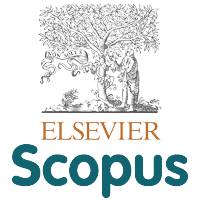Mycoparasitic Activity of Indigenous Trichoderma virens Strains Against Mungbean Soil Borne Pathogen Rhizoctonia solani: Hyperparasite and Hydrolytic Enzyme Production
Abstract
Keywords
Full Text:
PDFReferences
Abou-Taleb, K. A. A., Mashhoor, W. A., Nasr, S. A., Sharaf, M. S., & Abdel-Azeem, H. H. M. (2009). Nutritional and environmental factors affecting cellulase production by two strains of cellulolytic Bacilli. Australian Journal of Basic and Applied Sciences, 3(3), 2429–2436. Retrieved from pdf
Agrawal, T., & Kotasthane, A. S. (2012). Chitinolytic assay of indigenous Trichoderma isolates collected from different geographical locations of Chhattisgarh in central India. SpringerPlus, 1, 73. crossref
Angel, L. P. L., Sundram, S., Ping, B. T. Y., Yusof, M. T., & Ismail, I. S. (2018). Profiling of anti-fungal activity of Trichoderma virens 159C involved in biocontrol assay of Ganoderma boninense. Journal of Oil Palm Research, 30(1), 83–93. crossref
Angel, L. P. L., Yusof, M. T., Ismail, I. S., Ping, B. T. Y., Mohamed Azni, I. N. A., Kamarudin, N. H., & Sundram, S. (2016). An in vitro study of the antifungal activity of Trichoderma virens 7b and a profile of its non-polar antifungal components released against Ganoderma boninense. Journal of Microbiology, 54, 732–744. crossref
Baek, J. M., Howell, C. R., & Kenerley, C. M. (1999). The role of an extracellular chitinase from Trichoderma virens Gv29-8 in the biocontrol of Rhizoctonia solani. Current Genetics, 35, 41–50. crossref
Carling, D. E., Baird, R. E., Gitaitis, R. D., Brainard, K. A., & Kuninaga, S. (2002). Characterization of AG-13, a newly reported anastomosis group of Rhizoctonia solani. Phytopathology, 92(8), 893–899. crossref
Cattelan, A. J., Hartel, P. G., & Fuhrmann, J. J. (1999). Screening for plant growth-promoting rhizobacteria to promote early soybean growth. Soil Science Society of America Journal, 63(6), 1670–1680. crossref
Contreras-Cornejo, H. A., Macías-Rodríguez, L., Herrera-Estrella, A., & López-Bucio, J. (2014). The 4-phosphopantetheinyl transferase of Trichoderma virens plays a role in plant protection against Botrytis cinerea through volatile organic compound emission. Plant and Soil, 379, 261–274. crossref
Dennis, C., & Webster, J. (1971). Antagonistic properties of species-groups of Trichoderma: I. Production of non-volatile antibiotics. Transactions of the British Mycological Society, 57(1), 25–39. crossref
Djunaedy, A. (2008). Aplikasi fungisida sistemik dan pemanfaatan mikoriza dalam rangka pengendalian patogen tular tanah pada tanaman kedelai (Glycine max L.). Embryo, 5(2), 149–157. Retrieved from website
El-Hadi, A. A., El-Nour, S. A., Hammad, A., Kamel, Z., & Anwar, M. (2014). Optimization of cultural and nutritional conditionsfor carboxymethylcellulase productionby Aspergillus hortai. Journal of Radiation Research and Applied Sciences, 7(1), 23–28. crossref
Florencio, C., Couri, S., & Farinas, C. S. (2012). Correlation between agar plate screening and solid-state fermentation for the prediction of cellulase production by Trichoderma strains. Enzyme Research, 2012(793708), 1–7. crossref
Inayati, A., Sulistyowati, L., Aini, L. Q., & Yusnawan, E. (2019). Antifungal activity of volatile organic compounds from Trichoderma virens. In AIP Conference Proceedings (p. 080012). AIP Publishing LLC. crossref
Li, M. F., Li, G. H., & Zhang, K. Q. (2019). Non-volatile metabolites from Trichoderma spp. Metabolites, 9(3), 58. crossref
Meena, M., Swapnil, P., Zehra, A., Aamir, M., Dubey, M. K., Goutam, J., & Upadhyay, R. S. (2017). Beneficial microbes for disease suppression and plant growth promotion. In D. Singh, H. Singh, & R. Prabha (Eds.), Plant-Microbe Interactions in Agro-Ecological Perspectives (pp. 395–432). Singapore: Springer. crossref
Meena, M., Swapnil, P., Zehra, A., Dubey, M. K., & Upadhyay, R. S. (2017). Antagonistic assessment of Trichoderma spp. by producing volatile and non-volatile compounds against different fungal pathogens. Archives of Phytopathology and Plant Protection, 50(13–14), 629–648. crossref
Mohiddin, F. A., Khan, M. R., Khan, S. M., & Bhat, B. H. (2010). Why Trichoderma is considered super hero (super fungus) against the evil parasites? Plant Pathology Journal, 9(3), 92–102. crossref
Monfil, V. O., & Casas-Flores, S. (2014). Molecular mechanisms of biocontrol in Trichoderma spp. and their applications in agriculture. In V. K. Gupta, M. Schmoll, A. Herrera-Estrella, R. S. Upadhyay, I. Druzhinina, & M. G. Tuohy (Eds.), Biotechnology and Biology of Trichoderma (pp. 429–453). Elsevier. crossref
Muis, A. (2007). Pengelolaan penyakit busuk pelepah (Rhizoctonia solani Kuhn.) pada tanaman jagung. Jurnal Litbang Pertanian, 26(3), 100–103. Retrieved from pdf
Mukherjee, M., Mukherjee, P. K., Horwitz, B. A., Zachow, C., Berg, G., & Zeilinger, S. (2012). Trichodermaplant- pathogen interactions: Advances in genetics of biological control. Indian Journal of Microbiology, 52(4), 522–529. crossref
Nakkeeran, S., Vinodkumar, S., Priyanka, R., & Renukadevi, P. (2018). Mode of action of Trichoderma spp. in biological control of plant diseases. In Biocontrol of Soil Borne Pathogens and Hematodes (pp. 81–95). New Delhi, IN: Jeya Publishing house. Retrieved from website
Olaniyi, O. O., & Oyesiji, Y. V. (2015). Stimulatory effect of physicochemical factors on the expression of cellulase by Trichoderma viride NSPRT23. Microbiology Journal, 5, 58–67. crossref
Potprommanee, L., Wang, X. Q., Han, Y. J., Nyobe, D., Peng, Y. P., Huang, Q., … Chang, K. L. (2017). Characterization of a thermophilic cellulase from Geobacillus sp. HTA426, an efficient cellulaseproducer on alkali pretreated of lignocellulosic biomass. PLoS ONE, 12(4), e0175004. crossref
Qualhato, T. F., Lopes, F. A. C., Steindorff, A. S., Brandão, R. S., Jesuino, R. S. A., & Ulhoa, C. J. (2013). Mycoparasitism studies of Trichoderma species against three phytopathogenic fungi: Evaluation of antagonism and hydrolytic enzyme production. Biotechnology Letters, 35, 1461–1468. crossref
Rahayu, M. (2014). Identification and pathogenecity of pathogen responsible for aerial blight disease of soybean. Journal of Experimental Biology and Agricultural Sciences, 2(2S), 279–285. Retrieved from pdf
Rahayu, M. (2016). Patologi dan teknis pengujian kesehatan benih tanaman aneka kacang. Buletin Palawija, 14(2), 78–88. Retrieved from pdf
RStudio Team. (2015). RStudio: Integrated development for R. Boston, MA: RStudio, Inc.. Retrieved from website
Shahriarinour, M., Abd Wahab, M. N., Ariff, A., & Mohamad, R. (2011). Screening, isolation and selection of cellulolytic fungi from oil palm empty fruit bunch fibre. Biotechnology, 10(1), 108–113. crossref
Smitha, C., Finosh, G. T., Rajesh, R., & Abraham, P. K. (2014). Induction of hydrolytic enzymes of phytopathogenic fungi in response to Trichoderma viride influence biocontrol activity. International Journal of Current Microbiology and Applied Sciences, 3(9), 1207–1217. Retrieved from https://www.ijcmas.com/vol-3-9/C.Smitha,et al.pdf
Soesanto, L., Mugiastuti, E., Rahayuniati, R. F., Manan, A., Dewi, R. S. (2018). Compatibility test of four Trichoderma spp. isolates on several synthetic pesticides. AGRIVITA Journal of Agricultural Science, 40(3), 481-489. crossref
Strakowska, J., Błaszczyk, L., & Chełkowski, J. (2014). The significance of cellulolytic enzymes produced by Trichoderma in opportunistic lifestyle of this fungus. Journal of Basic Microbiology, 54(S1), S2–S13. crossref
Syed, S., Riyaz-Ul-Hassan, S., & Johri, S. (2013). A novel cellulase from an endophyte, Penicillium sp. NFCCI 2862. American Journal of MicrobiologicalResearch, 1(4), 84–91. crossref
Veena, D., Priya, H. R., Raheesa, M. K., & Divya, J. (2014). Soilborne diseases in crop plants and their management. Research & Reviews: Journal of Agriculture and Allied Sciences, 3(2), 12–18. Retrieved from website
Vipul, K., Mohammad, S., Mukesh, S., Anuradha, S., Sonika, P., & Manoj, K. M. (2015). Screening of Trichoderma species for virulence efficacy on seven most predominant phytopathogens. African Journal of Microbiology Research, 9(11), 793–799. crossref
Viterbo, A., & Horwitz, B. A. (2010). Mycoparasitism. In K. Borkovich & D. J. Ebbole (Eds.), Cellular and Molecular Biology of Filamentous Fungi (pp. 679–693). Washington, DC: ASM Press. Retrieved from website
Wang, K.-D., Borrego, E. J., Kenerley, C. M., Kolomiets, M. V. (2020). Oxylipins other than jasmonic acid are xylem-resident signals regulating systemic resistance induced by Trichoderma virens in maize. The Plant Cell, 32(1), 166-185. crossref
Wu, Q., Sun, R., Ni, M., Yu, J., Li, Y., Yu, C., … Chen, J. (2017). Identification of a novel fungus, Trichoderma asperellum GDFS1009, and comprehensive evaluation of its biocontrol efficacy. PLoS ONE, 12(6), e0179957. crossref
Xue, C. Y., Zhou, R. J., Li, Y. J., Xiao, D., & Fu, J. F. (2018). Cell-wall-degrading enzymes produced in vitro and in vivo by Rhizoctonia solani, the causative fungus of peanut sheath blight. PeerJ, 6, e5580. crossref
You, J., Zhang, J., Wu, M., Yang, L., Chen, W., & Li, G. (2016). Multiple criteria-based screening of Trichoderma isolates for biological control of Botrytis cinerea on tomato. Biological Control, 101, 31–38. crossref
Yusnawan, E., Inayati, A., & Baliadi, Y. (2019). Isolation of antagonistic fungi from rhizospheres and its biocontrol activity against different isolates of soil borne fungal pathogens infected legumes. Biodiversitas Journal of Biological Diversity, 20(7), 2048–2054. crossref
Zehra, A., Dubey, M. K., Meena, M., & Upadhyay, R. S. (2017). Effect of different environmental conditions on growth and sporulation of some Trichoderma species. Journal of Environmental Biology, 38(March), 197–203. crossref
Zhang, F., Ge, H., Zhang, F., Guo, N., Wang, Y., Chen, L., … Li, C. (2016). Biocontrol potential of Trichoderma harzianum isolate T-aloe against Sclerotinia sclerotiorum in soybean. Plant Physiology and Biochemistry, 100, 64–74. crossref
Zhang, S., Gan, Y., & Xu, B. (2014). Efficacy of Trichoderma longibrachiatum in the control of Heterodera avenae. BioControl, 59, 319–331. crossref
Zheng, A., Lin, R., Zhang, D., Qin, P., Xu, L., Ai, P., … Li, P. (2013). The evolution and pathogenic mechanisms of the rice sheath blight pathogen. Nature Communications, 4, 1424. crossref
DOI: http://doi.org/10.17503/agrivita.v0i0.2514
Copyright (c) 2020 The Author(s)

This work is licensed under a Creative Commons Attribution-NonCommercial 4.0 International License.








